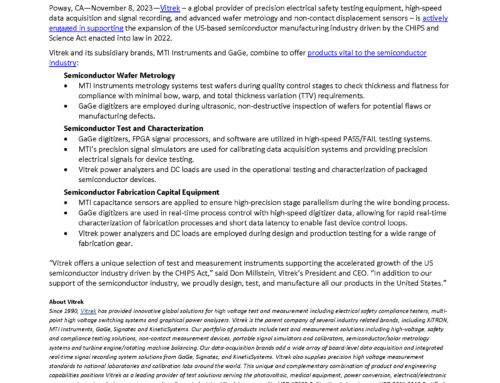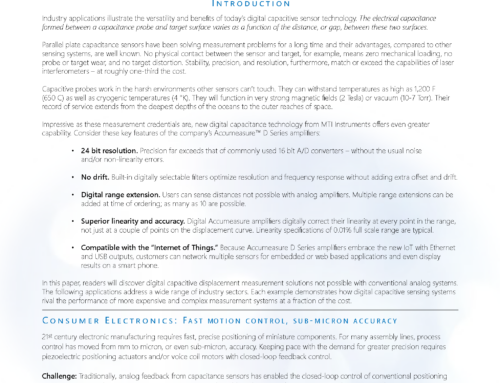
Testing for performance, energy effeciency, consumption verification, quality and safety compliance during product development.

Introduction
Manufacturers and users of LED lighting products need to ensure that their products meet the qualifications and requirements of a multitude of reliability and efficiency standards. In addition to voluntary initiatives and programs like EnergyStar, mandatory standards and specifications for the lighting industry must be kept in mind during project development, including the latest IES LM-79-19 and the ANSI C82.16 documents.
This application note provides an overview of relevant lighting standards and specifications for LED lighting products. It also describes how to test equipment, including power analyzers, DC loads and hipot testers, allow engineers and technicians to easily confirm that their LED lighting products meet the necessary parameters for performance, energy efficiency, consumption verification, quality and safety – before being sent for final compliance testing.
Industry Standards for LED Lighting
Over 40 years ago, during the U.S. oil crisis, the Department of Energy (DOE) established the Energy Policy and Conservation Act to compel manufacturers to develop products that meet certain efficiency specifications to save energy, including those for solid-state lighting (SSL) products. The focus of this white paper is on the mandatory standards/specifications for the LED lighting industry.
The following sections discuss the IES and ANSI mandatory standards, as well as the voluntary initiatives and programs that lead to certification and the product labeling (e.g. EnergyStar) that indicates compliance.
IES LM-79-19 Standard and Specification for SSL Lighting
Updated in 2019, the first time since 2008, the Illuminating Engineering Society’s (IES) LM-79-19 is the standard and specification for solid-state lighting applications. In addition to specifying optical measurements (lumens, chromacity, luminous flux, etc.), the LM-79- 19 has stringent system efficacy specifications. For the LED lighting applications, the relevant parameters fall under “AC Power Supply Standards” (sections 5.1-5.3), including:
1. Optical measurements (lumens, chromacity, luminous flux, etc.)
2. Electrical Power (voltage, current, power, power factor) with k=2 confidence interval. In the updated 2019 LM79 standard, the specifications for electrical power have been boosted from a K=1 to a k=2 “confidence interval.” This means that when doing calibrations, the measurement equipment must have a K=2 confidence level of being 95% accurate within plus or minus two standard deviations of the mean.
• AC Voltage (60 Hz) – 0.4% or less
• RMS Current – (0.5Hz to 1kHZ ) 0.6% or less – (1kHz to 100kHz) 2.0% or less
• AC Power – (0.5Hz to 1kHz) 1.0% or less – (1kHz to 100kHz) 2.0% or less
• DC Voltage – 0.1% or less
• DC Current – 0.1% or less
• Power Factor – PF>=0.7
3. System Efficiency (Lumens/Watt (Lm/W), Driver Efficiency, if not integrated)
4. Physical and environmental (temp, vibration, airflow, etc.)
As shown in Figure 1, the LED driver can be integrated into the LED lighting fixture itself. In this case, the input power coming into the luminaire’s LED driver (power supply), as well as its output power, must be measured using test equipment to compute system efficiency (Figure 1.)

Figure 1. Input/output power of a driver integrated into a LED fixture must be monitored to measure against the IES LM-79-19 for efficiency.
The ANSI C82.16-15 Standard & Specification for LED Drivers
Updated in 2015, the American National Standards Institute’s (ANSI) C82.16-15 is a mandatory standard and specification for the methods and measurement of LED driver input and output parameters. This includes:
• LED driver electrical input parameters; Voltage (open circuit voltage (OCV), peak, ripple), current (peak, ripple), power, power factor (pf) total harmonic distortion (THD), inrush
• LED driver electrical output parameters; Voltage (OCV, peak, ripple), current (peak, ripple) power, energy efficiency
Voluntary Energy Initiatives
In addition to mandatory EIS and ANSI standards/specifications, lighting products can be tested to meet voluntary national and state certification programs and initiatives that enable energy savings. These national and state programs/initiatives have different objectives and requirements, each with precise measurements and unique submission requirements to assure compliance. The ones that deal with LED lighting applications include:
• Energy Star – EPA/DOE programs – Minimum luminous efficacy (LED power <10W, 50 Lm/W; >=10W; 55Lm/W)
• Design Lights Consortium (DLC) – Utility-based programs – SSL technical requirements V5.1 (80-120 Lm/W, minimum efficacy), decided by product type (LED lamp, outdoor lighting, etc.)
• California Energy Commission (CEC) – Mainly energy efficiency – Standby power 200mW or less; PF 0.7 or greater
• LED Lighting Facts – DOE program is mandatory for Energy Star
• MSSL (Municipal Solid State Street Lighting) – DOE program focusing on outdoor lighting (streetlights, parking lots, garages, etc.)
When an LED lighting product completes qualification for one of these programs/initiatives, a label appears on the product packaging to show that the specification has been met (e.g. light output per Watt, etc.)
International Standards for Compliance Testing
The international Electric Commission (IEC) provide international standards that bring together the agreed-upon set of rules, specifications and terminology that allows manufacturers to have their devices tested for conformity. The following specifications are relevant for testing LED lighting systems:
• Power Consumption Testing: The EN50564:2011, which replaces IEC62301 specification, specifies test procedures for low-power consumption equipment and offers guidance for specifying measurement equipment, such as power analyzers, used for such tests. It describes how to test products with a supply voltage between 100V and 250V AC. It may also apply to 3-phase equipment. It may be used in conjunction with other standards for measuring energy efficiency, such as Energy Star and EU standby power directives.
• Harmonics Testing: EN61000-3-2 test standard specifies limits of harmonic components of the input current which may be produced by equipment tested under specified conditions. (Class C of the specification is for lighting devices.)
– IEC61000-3-12 deals with the limitation of harmonic currents injected into a system, such as a lighting system or
electrical ballast.
– IEC61000-4-7 is applicable to instrumentation intended for measuring spectral components in the frequency range
up to 9 kHz which are superimposed on the fundamental of the power supply systems at 50 Hz and 60 Hz.
Vitrek Testing Equipment for LED Lighting Products
As is apparent from the previous sections, there are four areas of parameters covered by industry standards as listed below, for LED lighting products. Therefore, to assure they will eventually pass UL, TUV, Intertek and SA testing, engineers and technicians should analyze these parameters during each phase of product development.
• Performance Parameters (design phase)
• Photometry (lighting measurements) lumens, chromacity, luminous flux
• Electrical (voltage, current, power)
Testing During Product Development
There are four key parameters for LED product: performance, energy efficiency, consumption verification and safety. To ensure a LED product will pass UL, TUV, Intertek and SA testing, engineers and technicians need to analyze these parameters during each phase of product development.
As shown in the table below, power analyzers, electronic DC loads, hipot testers, and high-voltage switches can be used to check compliance.
Application Example: Power Analyzers
A power analyzer can be used to measure LED lighting products during the design, production and verification phases of the device’s development. This enables the user to verify that the LED product meets all required specifications by showing the following parameters: voltage, current (ripple), power, apparent power (VA), reactive power (VAR), power factor (PF), frequency and efficiency (Figure 2).

Figure 2. A power analyzer’s power data screen shows key lighting parameters.
Driver Efficiency Testing
For LED driver efficiency testing, a power analyzer can be hooked up to an LED luminaire to make sure the product meets specifications for compliance. As shown in Figure 3, the back panel of the power analyzer shows two of the channels. On the LED driver side, the input to the LED driver is a 120V AC input signal and output is a DC signal (typically around 10 volts.) Also illustrated is how the 120V input power (the red and black wires) is routed and connected as channel 1 for voltage.
On the current side, the input current is routed into the power meter and back out (blue) to the input side of the LED driver, which means that the voltage and current are on channel 1. The output of the LED driver, the red/black connections for voltage, are connected to channel 2. For testing, the LED driver output current is run to channel 2 of the power analyzer and then back out. It is then connected to the LED luminaire. The various parameters are shown on display screens. In this way, the power analyzer calculates the output/input power of the LED driver by showing output, loss, and driver efficiency.

Figure 3. Back panel of a power analyzer connected to a LED luminaire using 1-to-4 channel connections.
Standby Power Testing
To simplify LED lighting compliance testing, the power analyzer has the portion of Energy Star’s EN5056:2011 5.3.2a specification for standby power built into the unit. In this application example, the analyzer is hooked up to a smart LED lighting fixture and the user can use a touch screen to view standby power in volts, etc., displayed on the screen.
When the measuring power in a standby power in a smart lighting application, the fixture itself can be turned off while its electronics are being constantly monitored to communicate over the internet or to an app. The power analyzer is useful for measuring standby power in this case as well.
Harmonics Emissions Testing
The user can also select which classification of EN61000 3-2 is displayed. As shown in Figure 4, the red “tick” marks on the harmonics screen indicate that the LED lighting device is failing the harmonics testing for the required Class A harmonics levels.

Figure 4. A power analyzer showing the specification for EN61000 (Class A) for harmonics testing.



